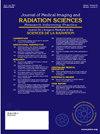Artificial Intelligence user interface preferences in radiology: A scoping review
IF 1.3
Q3 RADIOLOGY, NUCLEAR MEDICINE & MEDICAL IMAGING
Journal of Medical Imaging and Radiation Sciences
Pub Date : 2025-02-27
DOI:10.1016/j.jmir.2025.101866
引用次数: 0
Abstract
Introduction/Background
Modern forms of Artificial intelligence (AI) have developed in radiology over the past few years. With the current workforce shortages, in both radiology and radiography professions, AI continues to prove its place in supporting clinical radiology processes. The aim of the scoping review was to investigate the existing literature on the topic of preference of use of artificial intelligence interfaces within a radiology context.
Methods
Using a systematic approach, papers were chosen against an inclusion criterion of addressing radiological AI user interface preferences to be included in the scoping review. Arksey O'Malley's and Levac's framework were used to inform the procedural steps for the scoping review. Four databases were searched including MEDLINE Ovid, Scopus, Web of Science and Engineering Village. Reliability was improved through the involvement of three researchers to select the papers against the inclusion criteria.
Results
Six papers were identified to fit the inclusion criteria of radiological AI user interface preferences. These varied methodologically including two observational studies, two simulated user testing studies, a diagnostic accuracy study and a multi-case study. AI user interfaces were evaluated in two studies. Mixed responses were obtained with some alignment in preference for heatmap image overlays and highly detailed user interfaces are linked to higher preference amongst users. Limited literature exists on AI user interfaces and a lack of research evaluating current AI interface preference, either in post or pre-deployment.
Discussion
The mix of methods used within studies indicated that there is not yet a standardised method for assessing AI tool design and preference within radiology, with common use of a System Usability Scale survey tool in conjunction with another method. There was also a varied response when considering the preferred user interface in radiology, though simple, non-complicated designs were suggested to be ideal by participants.
Conclusion
Medical imaging AI user interface research is essential for the acceptability of AI technology into radiology departments. This scoping review identified the current landscape of AI user interface research within a radiology setting. There is a requirement for more radiology AI research focussing on end user or imaging professional involvement and their preferences. There is an explicit need for further research in the field, due to the lack of standardised outcome measures, lack clear findings regarding ideal user interfaces and lack of inclusion of radiographers. The dearth of studies including radiographers and small sample sizes of participants within these studies identifies the mindset shift required for radiology, and AI vendors alike.
放射学中的人工智能用户界面偏好:范围综述
在过去的几年中,现代形式的人工智能(AI)在放射学中得到了发展。由于目前放射学和放射摄影专业的劳动力短缺,人工智能继续证明其在支持临床放射学过程中的地位。范围审查的目的是调查在放射学背景下使用人工智能接口的偏好主题的现有文献。方法采用系统方法,根据解决放射人工智能用户界面偏好的纳入标准选择论文,将其纳入范围审查。Arksey O'Malley和Levac的框架被用于告知范围审查的程序步骤。检索MEDLINE Ovid、Scopus、Web of Science and Engineering Village 4个数据库。通过三位研究人员的参与,根据纳入标准选择论文,提高了可靠性。结果6篇论文符合放射学人工智能用户界面偏好的纳入标准。这些不同的方法包括两项观察性研究,两项模拟用户测试研究,一项诊断准确性研究和一项多案例研究。在两项研究中评估了人工智能用户界面。在热图图像叠加和高度详细的用户界面的偏好方面,得到了不同的反应。关于人工智能用户界面的文献有限,缺乏评估当前人工智能界面偏好的研究,无论是在部署后还是部署前。研究中使用的混合方法表明,目前还没有一种标准化的方法来评估放射学中人工智能工具的设计和偏好,通常使用系统可用性量表调查工具与另一种方法相结合。当考虑到首选的放射学用户界面时,也有不同的反应,尽管参与者建议简单,不复杂的设计是理想的。结论医学影像人工智能用户界面的研究是人工智能技术进入放射科的关键。这一范围审查确定了放射学环境下人工智能用户界面研究的现状。需要更多的放射学人工智能研究,重点关注最终用户或成像专业人员的参与及其偏好。由于缺乏标准化的结果测量,缺乏关于理想用户界面的明确发现以及缺乏纳入放射技师,因此明确需要在该领域进行进一步研究。包括放射技师在内的研究的缺乏和这些研究中参与者的小样本量确定了放射学和人工智能供应商等所需的思维转变。
本文章由计算机程序翻译,如有差异,请以英文原文为准。
求助全文
约1分钟内获得全文
求助全文
来源期刊

Journal of Medical Imaging and Radiation Sciences
RADIOLOGY, NUCLEAR MEDICINE & MEDICAL IMAGING-
CiteScore
2.30
自引率
11.10%
发文量
231
审稿时长
53 days
期刊介绍:
Journal of Medical Imaging and Radiation Sciences is the official peer-reviewed journal of the Canadian Association of Medical Radiation Technologists. This journal is published four times a year and is circulated to approximately 11,000 medical radiation technologists, libraries and radiology departments throughout Canada, the United States and overseas. The Journal publishes articles on recent research, new technology and techniques, professional practices, technologists viewpoints as well as relevant book reviews.
 求助内容:
求助内容: 应助结果提醒方式:
应助结果提醒方式:


